

Building mental resilience for the future of work. HR leaders must invest in mental health resources and continue to have open and honest conversations with employees around mental wellbeing.

In March 2020, we witnessed a massive transition that would transform the future of work. Workplaces immediately shifted to remote work — in some cases, over the course of a weekend —to protect the health and safety of their workers. Now, as we approach the next phase of this evolution, organizations and employees are faced with another ripe opportunity to redefine work for the better. As a chief people officer, I’ve managed diverse teams globally and believe building mentally resilient workplaces starts with creating an employee-first framework. Future-proofing the organization the ‘helix’ way. Balancing flexibility and stability is the goal of any organizational structure.

In fast-changing industries, flexibility supports the mastery of technological shifts while stability provides the much-needed efficiency to scale them up. Yet, too much flexibility breeds inefficiency or even disorder. And too much stability invites inertia and bureaucracy. Locating the sweet spot is elusive. Julian Fieres and his team are trying to find it—and bring the organization along with them. Fieres, the head of transformation, strategy, and sustainability at ZF Friedrichshafen AG (ZF), Electrified Powertrain Technology division, is in the thick of a transformation involving two newly merged business units that together account for 30,000 employees and $10 billion in annual sales. McKinsey: Describe the situation ZF faced in 2020. Julian Fieres: For context, we should start further back. Workplace resilience statements. How to achieve organisational resilience through emotional intelligence - Lessons from Airbus’ group project “+ Emotional energy @ work” (July 2021)
Business Resilience. Change Resiliency – The Secret Recipe for Organizational Culture. Antifragility: A Proven Concept That Can Help You during the Next Year. The phrase below (you will discover in a few paragraphs how it relates to Antifragility) was part of a dialogue between the author of Freakonomics, Stephen Dubner, and the Lebanese writer and trader Nicholas Nassim Taleb: If you look at ten or twenty or thirty of the richest countries around the world, among the richest people in those countries is someone from Lebanon.
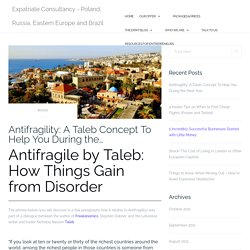
We could say that this is also valid for other nationalities in some specific cases, like Chinese students in the Ivy League universities or Indians in C-Positions at Fortune 500 companies. However, the comparison falls short when we consider how Lebanese are over-represented in multiple countries, in multiple positions of power — from business to academia and politics. Besides, while China and India are gigantic emerging economies, Lebanon is a tiny, turbulent country with fewer inhabitants than the Czech Republic. Taleb was not bragging about his own country. They also influenced the political arena in Brazil. How Do You Create a Resilient Workforce? What are the biggest traits of a resilient workforce?
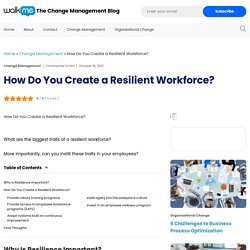
More importantly, can you instill these traits in your employees? Why Is Resilience Important? Business continuity and organizational resilience became trending topics in 2020. Transform for Resilience: An Imperative for Good Times Too. Don’t Overlook Resilience in Good Times The playbook for resilient transformations differs in a few ways from those that primarily aim to increase efficiency and optimize short-run financial performance.
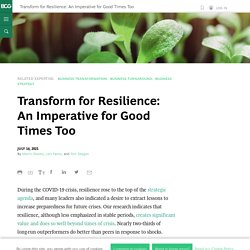
Transforming for resilience requires a new mindset that unfortunately tends to fade as stability and prosperity return. Our research indicates that, when a crisis is fresh, leaders are more likely to adopt an approach to transformation that is consistent with building resilience. The COVID Scoreboard: How Resilient Businesses Emerged New Winners. By Martin Reeves, Yuval Shmul, and David Zuluaga Martínez Businesses often frame crises as periods when the focus should be on risk and damage mitigation.
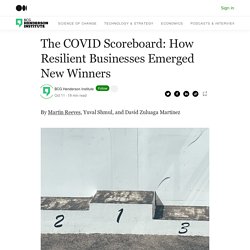
However, for a resilient company, crises can instead offer opportunities for differential growth and advantage. Our previous research demonstrates that resilience — the capacity to absorb stress, recover critical functionality, and thrive in altered circumstances — has significant strategic value. Because crises widen the gap between top and bottom performers, ~30% of a company’s long-run relative TSR is driven by how they perform during crises.
Building post-pandemic team resilience. The pandemic has brought more than a year of unprecedented hardship.
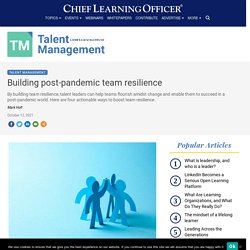
And while the future is looking brighter with the global push for vaccinations, workers continue to struggle with mental health issues and resilience on a grand scale. According to a recent Hardvard Business Review and YMCA WorkWell study by Jennifer Moss, nearly 90 percent of survey respondents felt their work lives were getting worse during the pandemic. More than 60 percent indicated they were experiencing burnout often or very often. These findings have huge implications for organizations in terms of employee health, engagement, performance and retention.
Future-proofing the organization the ‘helix’ way. Balancing flexibility and stability is the goal of any organizational structure.

In fast-changing industries, flexibility supports the mastery of technological shifts while stability provides the much-needed efficiency to scale them up. Yet, too much flexibility breeds inefficiency or even disorder. And too much stability invites inertia and bureaucracy. Locating the sweet spot is elusive. Julian Fieres and his team are trying to find it—and bring the organization along with them. Fieres, the head of transformation, strategy, and sustainability at ZF Friedrichshafen AG (ZF), Electrified Powertrain Technology division, is in the thick of a transformation involving two newly merged business units that together account for 30,000 employees and $10 billion in annual sales. Lunchtime Learning for Leaders: 16 Ways to Grow Your Resilience and Influence (3 October 2021) by Lucy Ryan. Expect the unexpected: Five tips to help you confidently handle curve balls in the workplace.
“To expect the unexpected shows a thoroughly modern intellect” – Oscar Wilde I think Oscar was missing a trick when he said that.
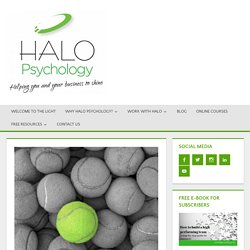
Based on recent conversations with coaching clients, I think to expect the unexpected also requires a certain level of confidence in your own ability to handle whatever life might throw at you. Many of my clients find that the even best laid plans for the day, week, month or year can get pushed to the side in the face of the unexpected.
The unexpected might be a crisis or emergency, or it might just be the latest shiny thing that the top boss has deemed a priority. 7 techniques for resilience. Business Unusual: Values, Uncertainty and the Psychology of Brand Resilience (28 September 2021) by Nathalie Nahai. Developing Mental Toughness: Strategies to Improve Performance, Resilience and Wellbeing in Individuals and Organizations, 3rd Ed. (28 September 2021) by Peter Clough, Doug Strycharczyk and John Perry. Book summary: Emotional Habits - 7 Things Resilient People Do Differently by Akash Karia. Peak performance coach Akash Karia discusses the seven major habits of “emotionally resilient” people and explains how to integrate these behaviors into your life.
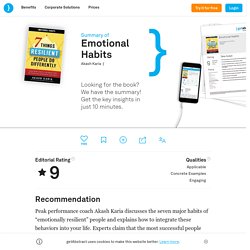
Experts claim that the most successful people aren’t necessarily the most intelligent or best educated; they’re the most emotionally resilient. They don’t let negative emotions cloud their judgment. The Importance of Organizational Resilience in the Digital Age. Transform for Resilience: An Imperative for Good Times Too. Building Resilience - A roadmap for the modern C-suite. Whole person leadership resilience Just as adversities in real life often overlap, the three realms also act interdependently. As part of the curriculum, the series explored how these dimensions arise in relationships and offered participants tangible ways to apply what they learned. For example, in the interpersonal realm, connection was covered, including the ability to build and nurture supportive, authentic relationships based in empathy, shared values, and constructive communication.
In the extrapersonal realm, participants learned environmental agility—the ability to sense the “health” of environmental conditions and mitigate the impact of suboptimal life and workplace forces. “The sentiment we got from participants was that ‘This is easy to apply, but I’ve never done it,’” says Natalie Melamed, the program’s co-lead, and a senior manager in Deloitte LLP’s Executive Accelerators. Lessons in Resilience from Companies That Were Down but Never Out. The digital and omnichannel business now earns more than $3 billion in revenue, and in 2020, the company brought in 10.6 million new digital customers (nearly double the number in 2019), of whom 5 million were new to the brand.
As of mid-2021, the stock price was hovering around $30, up from $10 immediately prior to the announcement of Tritton’s hiring. Bed Bath & Beyond is building on this momentum and recently announced ambitious environmental, social, and governance commitments to support people, community, and planet. By boldly and proactively addressing longstanding structural challenges, the leadership team was able to respond to the pandemic effectively and position the company for future growth. What the US Army can teach us about building resilient teams. Burnout has become one of the most talked-about workplace topics, and its impact is far-reaching. A global pandemic, social unrest, and the 24/7 pace of work have combined to create a tsunami of stress for workers, and much of it seems as though it’s outside the organization’s control.
But there is help, and no one should have to go it alone. My familiarity with burnout and knowledge of how it can be prevented have been informed by my experience recovering from burnout while working as a lawyer, interviewing others about their burnout experiences, coaching clients, teaching and training thousands of people, and studying the evolving research.
For those confronting the problem, the first step is understanding what burnout is and what it isn’t. Burnout is more than feeling tired because you’re working on a big project or because you’re in the middle of your busy season. Without a doubt, burnout is complex. The US Army’s program. Rogue Waves: Future-Proof Your Business to Survive and Profit from Radical Change (17 August 2021) by Jonathan Brill. What does resilience mean in capital and balance-sheet management? Resilience begins with trying to understand the future—scanning the horizon, generating scenarios, anticipating likely effects, and assessing the resources through dynamic management and a flexible operating model. Efficiency has been the priority for the past decade, but now businesses are moving to a dual way of thinking. They are planning for uncertainty by, for example, building in buffers for inventory, especially for “bottleneck” components and capital, so they can withstand periods of significant cashflow reduction.
Even before the pandemic, uncertainty was rising. Brexit and trade disputes are affecting global supply chains. Decarbonization is having a profound impact on many industries and regions. On increasing your resilience to change. Resilience at the level of individuals and organizations. Organizing For Resilience: Leading and Managing Risk in a Disruptive World (12 July 2021) by Christopher Williams and Jacqueline You Jing. What are your top relational sources of resilience? Webinaire "Résilience émotionnelle" Enterprise resilience. Purpose In his book Start with why: How great leaders inspire everyone to take action, the inspirational speaker Simon Sinek describes how many organizations and leaders make the mistake of starting with what they want to accomplish, instead of asking whytheir organization exists and acts. Companies that are driven by a clear purpose, a clear sense of why, can more effectively create strong connections to customers, employees, and society writ large, leading to better business outcomes.
Studies suggest that purpose-driven companies outperform the market 15 to one, experience higher market share gains, and grow, on average, three times faster than their competition.4 In recent times, the need for organizations to answer their why has also taken on increased societal importance. Especially amidst the fog of pandemic in 2020, purpose became a beacon of light for the executives we interviewed. Other organizations sought to generate that purpose when it wasn’t immediately clear. Values Mission. Operational resilience in real time. Why good mental health is crucial for transformation.
Five years ago, Deepak Shukla became so depressed that he called the Samaritans for his own protection. On demand webinar: Resilience & Transformation Through Crisis and Recovery. Building resilience across your organization. 7 mental health activities to try out during your week. How boards can help companies develop resilience. Boards of directors play a critical role in ensuring that management is well prepared for a wide range of potential shocks. In the fourth episode of our series on board perspectives around the most important issues facing organizations, the Inside the Strategy Room podcast looks at the role that boards play in building resilient companies. Frithjof Lund, who heads our board services work, leads a discussion with Gordon Orr, a nonexecutive member of several companies’ boards and a McKinsey senior partner emeritus, and Martin Hirt, the global co-leader of McKinsey’s Strategy & Corporate Finance Practice.
This is an edited transcript of the discussion. Three Actions to Reduce the Stress of Change. Lessons on Resilience for Small and Midsize Businesses. Courses on resilience. The Journey Of Resilient Leadership: Building Organizational Resilience. LinkedIn by Linda Hoopes. The Resilience Quotient. Organization Resilience Index. Organizational resilience is a vital aspect to ensuring business leaders constantly remain future-ready.
Why we all need to practice emotional first aid. Mental Toughness..Need of the hour !! Business Continuity Management: A Practical Guide to Organizational Resilience and ISO 22301 (27 April 2021) by James Crask. How to Use Lean Thinking to Boost Agility and Resilience. Podcast Series on Resilience. 4 Ways to Create Resilient Teams, Not Just Resilient Individuals. This past year has tested even the most highly functioning and irrepressible of teams. LinkedIn by David McLean. Understanding and managing stress. April 4, 2021When a container ship got stuck in one of the world's busiest trade routes late last month, many pondered the implications for supply chains as stakeholders worked to resolve the issue.
With business back to usual, the situation nonetheless serves as a stark reminder of how important well-functioning supply and value chains are, as well as the consequences when they break down. Take back control – friend to friend. Report: Organization Resilience Index 2021. Make stress your ally, not your enemy. Strategic resilience during the COVID-19 crisis. Need More Capacity for Change? Focus on Stress Over Resilience. Report: The Top 10 Findings on Resilience and Engagement. How to build organizational resilience. How To Thrive In A Post Covid-19 World. As Pandemic Fatigue Sets in at Work, Employers Try to Help. Make stress your ally, not your enemy. Anguish in the Remote C-Suite. What causes your window of tolerance to expand/shrink? HBR's 10 Must Reads on Organizational Resilience (23 février 2021) by Harvard Business Review. Building Resilience.
The Secret to Building Resilience. Building the resilient organization - 2021 Deloitte Global resilience report. 5 ways leaders can strengthen change resilience in challenging times. LinkedIn by Annapurna A. Getting Business Resilience Right. General Stanley McChrystal: How to Lead Resilient Teams Through Uncertainty. Resilience Is About How You Recharge, Not How You Endure. 7 Strategies to Build a More Resilient Team. LinkedIn by David Komlos and David Benjamin via Gail Severini. 8 steps to become more resilient. How to Push Through Second-Wave Fatigue and Beat Your Exhaustion Resiliency: Leading Change in a VUCA World. Poem: We'll all be home for Christmas, if only on our screens. Why increasing organizational resilience to change matters.
Embrace the Suck: The Navy SEAL Way to an Extraordinary Life (22 December 2020) by Brent Gleeson. LinkedIn by David McLean. LinkedIn by Annapurna A. How to be resilient. Messy maps: Qualitative GIS representations of resilience. Your ‘Surge Capacity’ Is Depleted — It’s Why You Feel Awful. Here’s how to pull yourself out of despair and live your life. LinkedIn by David McLean through Romy Schnaiberg. HBR's 10 Must Reads on Organizational Resilience (24 November 2020) by Harvard Business Review (collective)
Report: Resilience in an Age of Uncertainty. Creating a resilient and optimistic workplace. MIT Sloan Management Review. Workplace Resilience Study. If You Want to Build Resilience Stop Saying These Words. LinkedIn by Jacinta M. Jiménez, PsyD through Gail Severini. 6 Principles to Embrace Resilience and Responsiveness. What Really Makes Us Resilient? How to Cope When Everything Keeps Changing. Hidden perils of unresolved grief. Your organization is grieving. Why increasing organizational resilience to change matters.